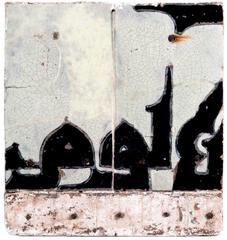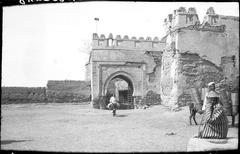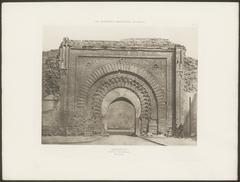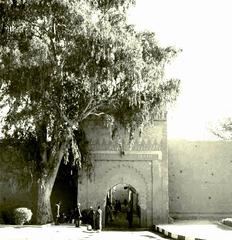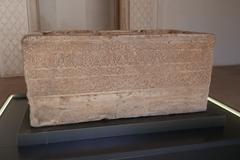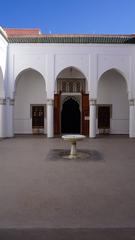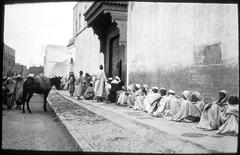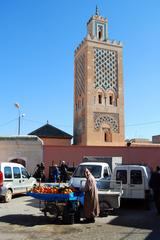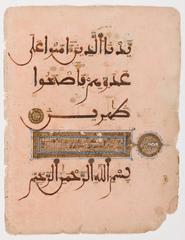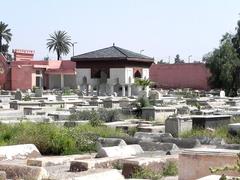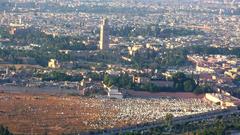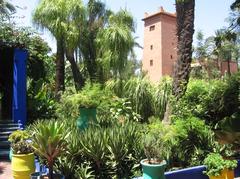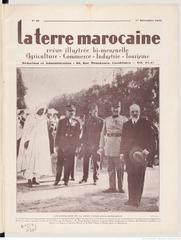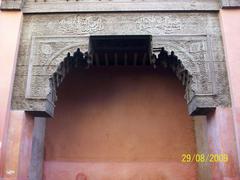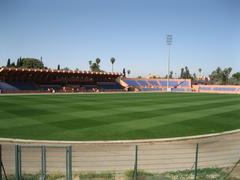Sidi Bel Abbes Zawiya: Visiting Hours, Tickets, and Historical Significance in Marrakesh
Date: 14/06/2025
Introduction
Nestled within Marrakesh’s historic medina, the Sidi Bel Abbes Zawiya is a cornerstone of spiritual, architectural, and cultural life in Morocco. Dedicated to the revered 12th-century Sufi saint Sidi Bel Abbes Sebti, known as the “Patron of the Poor,” the zawiya (religious complex) has evolved into a vibrant center of worship, charity, education, and pilgrimage. Its intricate Moroccan-Islamic architectural features—such as zellij tilework, carved cedar ceilings, and a distinctive five-arched fountain—reflect centuries of royal patronage and dynastic restoration. Today, the zawiya continues to serve the local community and attracts visitors worldwide, drawn by its profound religious significance and artistic beauty (Moroccan Journeys, Zawyaty, trek.zone).
This detailed guide covers the history, architectural highlights, visiting hours, entry policies, etiquette, accessibility, and practical travel tips to help you appreciate the Sidi Bel Abbes Zawiya and plan a respectful, enriching visit.
Historical Overview and Cultural Significance
The Legacy of Sidi Bel Abbes
Sidi Bel Abbes Sebti (c. 1145–1204 CE), born in Ceuta, is one of Morocco’s most venerated Sufi saints. Renowned for his scholarship, humility, and compassion towards the poor and blind, he became a spiritual protector of Marrakesh and a central figure in the “Seven Saints of Marrakesh” pilgrimage circuit. His teachings emphasized service, generosity, and social justice, values that continue to inspire Moroccan Sufism (Moroccan Journeys).
Formation and Architectural Evolution of the Zawiya
Initially established outside the city walls near Bab Taghzout, the zawiya was commissioned by Saadian ruler Abu Faris al-Wathiq in 1605 and quickly became a focal point for religious and social life (AssignmentPoint). Successive dynasties, including the Saadians and Alaouites, expanded and restored the complex, integrating it into Marrakesh’s urban fabric. Notably, Sultan Moulay Isma’il (r. 1672–1727) and Sultan Muhammad ibn Abdallah (r. 1757–1790) undertook significant renovations, including the rebuilding of the mausoleum and madrasa (Everything Explained).
The Zawiya’s Social and Spiritual Role
Beyond its religious functions, the zawiya has long served as a center for charity, education, and social welfare. It provides food, shelter, and medical aid to the poor, continuing Sidi Bel Abbes’s legacy. The zawiya also houses a refuge for the blind, reflecting the saint’s special care for the visually impaired. Annual pilgrimages, especially the Seven Saints festival, draw thousands of devotees seeking blessings (baraka) and spiritual renewal. The zawiya’s welcoming ethos extends to visitors of all backgrounds who approach with respect.
Site Layout and Architectural Highlights
Complex Organization
The Sidi Bel Abbes Zawiya is organized around two main courtyards and comprises several interconnected structures:
- Mausoleum: The central tomb chamber, rebuilt in 1720, features a domed roof and serves as the spiritual heart of the complex.
- Mosque: Facilitates daily prayers and larger religious gatherings.
- Madrasa: Provides religious education and study spaces, rebuilt in the 18th century.
- Five-Arched Fountain: A distinctive public feature at the entrance, combining function and artistry (Visit Marrakech).
- Blind Refuge: Integrated into the site, offering shelter and services for the visually impaired (Best Medina).
Decorative Elements
- Zellij Tilework: Hand-cut glazed tiles form intricate geometric mosaics on floors and walls.
- Carved Cedar Ceilings: Painted and elaborately carved, these ceilings are hallmarks of Moroccan religious architecture.
- Stucco and Plasterwork: Stucco is carved with arabesque and calligraphic motifs, framing arches and niches.
- Ironwork: Ornate metal grilles protect the fountain and entryways.
- Domed Mausoleum Chamber: Symbolizes the sanctity of the saint’s tomb.
Stylistic Influences
The site’s layered architecture reflects Saadian solidity and Alaouite decorative flourish, with later additions ensuring preservation of its unique features (Archiqoo). The result is a harmonious blend of structure, ornament, and function.
Visiting Information
Hours and Entry
- Open: Daily, typically from 9:00 AM to 6:00 PM, though hours may vary during religious holidays or special events. Always check locally before your visit.
- Entry: Free of charge. Donations are welcomed to support maintenance and charitable activities. Access to the inner sanctum (mausoleum and mosque) is reserved for Muslims (Marrakech City Guide).
Location and Access
- Address: Near Bab Taghzout, northwestern medina, Marrakesh.
- Getting There: Walkable from Jemaa el-Fnaa (15–20 minutes) or accessible by petit taxi; drivers recognize Bab Taghzout.
- Mobility: The medina’s narrow, uneven streets limit wheelchair access; assistance is recommended for visitors with mobility challenges.
Guided Tours
- Local guides and organized tours offer valuable context and facilitate respectful access. Guides can be booked through riads or local agencies.
Dress Code and Etiquette
- Dress Modestly: Shoulders, arms, and knees covered; women should bring a scarf for hair covering.
- Respect Sacred Spaces: Remove shoes before entering prayer areas, maintain silence, and avoid disruptive behavior.
- Photography: Allowed in exterior courtyards and public areas; always ask permission before photographing people or inside religious spaces.
Facilities and Amenities
- The zawiya itself has no tourist amenities. Nearby cafés offer restrooms and refreshments.
- Shops in the neighborhood sell religious items and Moroccan crafts. Carry small cash for donations or purchases.
Safety and Communication
- The area is generally safe, especially in daylight. Secure valuables and be mindful in crowded areas.
- Arabic (Darija) and French are widely spoken; English is less common, but basic greetings are appreciated.
Special Events and Pilgrimages
During the annual Seven Saints pilgrimage, the zawiya becomes a vibrant hub of religious activity, with processions, communal prayers, and festive gatherings. Non-Muslim visitors should observe from a respectful distance during these times and expect larger crowds and stricter access controls.
Frequently Asked Questions (FAQ)
Q: What are the visiting hours of Sidi Bel Abbes Zawiya?
A: Typically open from 9:00 AM to 6:00 PM. Hours may vary during holidays; check locally.
Q: Is there an entry fee or ticket required?
A: No, entry is free. Donations are appreciated.
Q: Can non-Muslims enter the mausoleum?
A: No, only Muslims may access the inner sanctuary and mausoleum; all visitors are welcome in the outer areas.
Q: Are guided tours available?
A: Yes, local guides can be arranged for historical and cultural insight.
Q: Is the site accessible for wheelchairs?
A: Accessibility is limited due to narrow, uneven medina streets.
Q: Are there facilities like restrooms or cafés on-site?
A: No; nearby cafés may offer restrooms.
Practical Travel Tips
- Visit during daylight hours for safety and convenience.
- Dress modestly and bring a scarf (women).
- Avoid eating, drinking, or smoking near entrances, especially during Ramadan.
- Be discreet with photography, and always ask permission.
- Carry small change for donations and local purchases.
- Observe local customs and follow the lead of local worshippers.
Summary
Sidi Bel Abbes Zawiya stands as a living testament to Marrakesh’s spiritual heritage, Sufi traditions, and Moroccan artistry. Its blend of charitable activity, religious devotion, and architectural splendor invites visitors to reflect on Morocco’s rich cultural legacy. Observing respectful etiquette and planning your visit with the information above will ensure a meaningful and memorable experience.
For more details, see these reliable resources:
For up-to-date guides and interactive audio tours, download the Audiala app and follow us on social media for travel tips and event updates.
